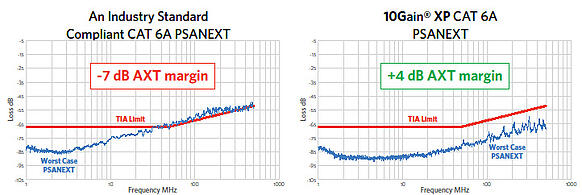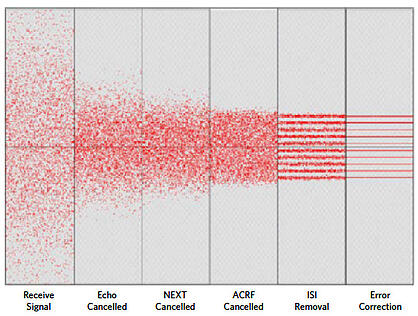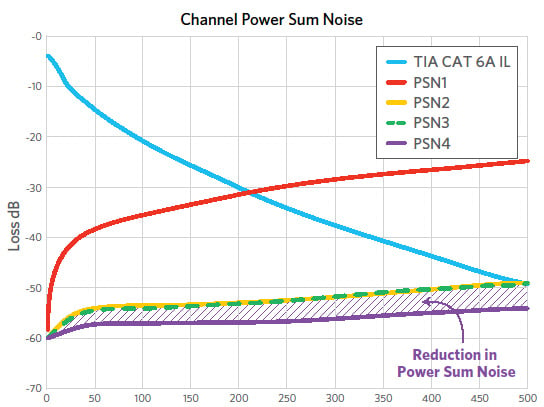Today’s Category 6A systems are increasingly impacted by noise pollution. Typical environments for data centers are characterized by many ethernet protocols running across a significant volume of cable of different designs, performance levels, and manufacturers’ brands. All these cables provide a very noisy environment for 10GBASE-T systems.
It is generally understood by most in the telecom industry that active equipment is able to eliminate much of the internally generated noise within a 10GBASE-T channel. However, many are not aware that cancellation technology has improved to the point at which alien crosstalk (AXT) is now the limiting factor in the overall noise level of 10GBASE-T systems.

The Ethernet protocol for 10Gb/s over twisted pair cabling, IEEE 802.3an 10GBASE-T, uses a standard CAT 6A cabling channel. CAT 6A cabling performance requirements are defined in TIA-568-C.2. CAT 6A component requirements are set for constructing reference implementation channels, up to 100m length with 4 connectors, thus providing a minimum performance necessary to support 10GBASE-T data link operating at maximum 10-12 BER.
The ideal cabling channel has no loss and no noise, because the two transceivers at the ends of a link are connected directly to each other. By introducing cabling component losses into the channel, from intervening cable and connectors, the signal level is lowered and the noise level is raised; the signal-to-noise ratio (SNR) is reduced as well as the system capacity.

10GBASE-T uses five times as much bandwidth as 1000BASE-T and 10GBASE-T operates at 5 times higher frequencies than 1000BASE-T where a good SNR is more challenging to achieve. 10GBASE-T uses much more of the available CAT 6A channel capacity over its channel bandwidth than 1000BASE-T uses over its CAT 5e channel bandwidth. 10GBASE-T transmits symbols at a much faster rate, and with much more complexity than 1000BASE-T.
In the typical CAT 6A application, there will be a significant volume of cables bundled together
and each cable will be transmitting a portion of its signal onto the adjacent cables. This coupling of transmitted signal onto adjacent cables is known as alien crosstalk (AXT), and it is a key contributor to the overall noise level in a CAT 6A channel. The sensitivity of 10GBASE-T to noise is the reason that AXT is a factor in overall data transmission performance.

In a perfect world, all CAT 6A cables and connectivity would be perfectly balanced. In reality, there are asymmetries between tip and ring conductors, which cause capacitance and inductance between each conductor and a virtual ground to be different (unbalance). This unbalance can increase crosstalk coupling between adjacent cables beyond the levels that the cables are specified for. Additionally, unbalances within connecting hardware (connectivity) can generate noise that is transmitted down the disturber cable to create additional differential noise in victim cables.
In the TIA-568-C.2 requirement for alien crosstalk, CAT 6A designs are tested in a 6-around-1 design using identical cables. In actual installations, different Category cables (e.g., CAT 5e or CAT 6) are often installed adjacent to these CAT 6A cables. The impact of these adjacent cables can be significant if the CAT 6A cable is not sufficiently immune to alien crosstalk (AXT). All of these aforementioned factors can introduce additional alien noise that the typical CAT 6A cabling system is not necessarily designed to protect against.

Noise cancellation technologies employed by PHY chips used in today’s 10GBASE-T system have
improved greatly since 2006 when 10GBASE-T was first ratified. The consequence of these technical advancements is that the effective noise level in the channel from internal crosstalk (PSNEXT, PSACRF) is now much lower than the noise levels caused by alien crosstalk. Although all types of noise sources are mitigated by 10GBASE-T coding technologies, true noise cancellation is not effective on alien crosstalk-induced noise.
As a result of these active component noise cancellation techniques, alien crosstalk is now the limiting noise factor in CAT 6A channels. In order to lower the total noise level in a CAT 6A channel, reduction in AXT noise is necessary. Today’s 10GBASE-T transceivers are not able to cancel noise received from adjacent cables. Consequently, the most effective way to add margin to the channel performance is to choose a cabling system that provides guaranteed alien crosstalk margin above the TIA-568-C.2 minimum requirements.
The corollary to this finding is that CAT 6A cabling systems that provide guaranteed margin for NEXT, PSNEXT, ACRF, PSACRF, and RL are not providing the system with any additional true benefit in terms of lowering the total noise level in a CAT 6A channel.
For more information regaring Superior Essex wire and cable, please contact your local Accu-Tech representative here. To learn more about limiting alien crosstalk, check out this white paper courtesy of Superior Essex.


.png?width=58&height=58&name=X_logo_2023_(white).png)
